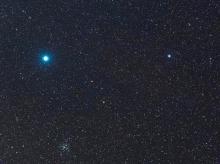Listen to today's episode of StarDate on the web the same day it airs in high-quality streaming audio without any extra ads or announcements. Choose a $8 one-month pass, or listen every day for a year for just $30.
You are here
Mirzam
The Big Dog trots across the southern sky on December nights. It’s easy to spot because it’s home to Sirius, the brightest star in the night sky. Sirius rises in the southeast in mid-evening, with the rest of the constellation below it and to the sides.
Sirius really is a fairly bright star. But it’s a mere firefly compared to some of the other stars of Canis Major. One example stands close to the right or upper right of Sirius during the evening.
Mirzam looks much fainter than Sirius, but that’s a bit of a trick. The star is really thousands of times brighter. But it’s also much farther — about 500 light-years, versus less than nine light-years for Sirius.
That means that Mirzam is quite a stunner. When you add up all forms of energy, it’s thousands of times brighter than Sirius, and tens of thousands of times brighter than the Sun.
The key to its brightness is the star’s mass. It’s so heavy that its gravity squeezes its core tightly. That’s like mashing your foot down on your car’s accelerator — it revs up the reactions in the star’s core. As a result, the core produces much more energy. But also like a gas-powered car, mashing down the pedal uses up the fuel much more quickly. So Mirzam will live about one-tenth of one percent as long as the Sun will. When its time is up, it’ll explode as a supernova — a brilliant ending for a brilliant star.
We’ll talk about an impressive star in the Little Dog tomorrow.
Script by Damond Benningfield




